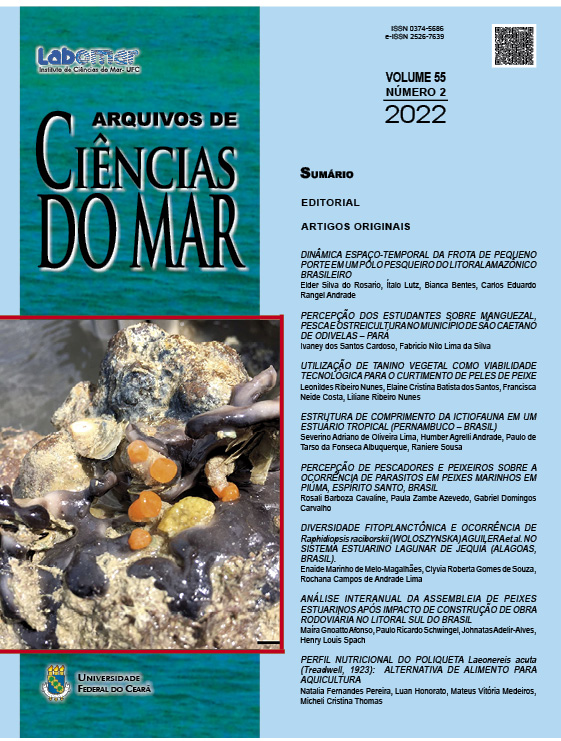Length structure of ictiofauna in a tropical estuary (Pernambuco-Brazil)
DOI:
https://doi.org/10.32360/acmar.v55i2.71245Abstract
Estuaries are habitats favorable to occupation by several species of fish, due to the availability of shelter and nutrients. Among the various fishery resource management tools, studies based on the size of specimens are useful for a better understanding of the structure of the estuarine community. Also, they can be associated with reproductive aspects and selectivity of fishing gears, useful for mitigating the effects of overfishing. In the present study, the lengths of fish species captured with gillnet were spatially assessed in a tropical estuary in the state of Pernambuco, in horizontal stretches (center and margins) and depths (upper, intermediate, and lower) between July 2013 and June 2014. Among the most captured fish species, juvenile individuals were predominant in the species Chloroscombrus chrysurus Harengula clupeola, Lycengraulis grossidens, Opisthonema oglinum and Anchovia clupeoide, which had an average length of 6.47 cm, 9.59 cm, 9.93 cm, 11.25 cm and 12.17 cm, respectively, while Strongylura marina occurred adult individuals who had a mean length of 42.43 cm. The length structure of the main fish was composed of juveniles, but the lengths were
longer in the dry season for the most caught species O. oglinum and A. clupeoides. The maximum lengths found for O. oglinum were twice as short as those found in the 1970s. Therefore, there is a need to implement measures that aim to protect the estuary of the Santa Cruz Channel in order to conserve fish stocks in the region.
Keywords: Clupeidae, artisanal fishing, pelagic fish, gillnet.
Downloads
Published
Issue
Section
License
1. Proposta de Política para Periódicos de Acesso Livre
Autores que publicam nesta revista concordam com os seguintes termos:
- Autores mantém os direitos autorais e concedem à revista o direito de primeira publicação, com o trabalho simultaneamente licenciado sob a Licença Creative Commons Attribution que permite o compartilhamento do trabalho com reconhecimento da autoria e publicação inicial nesta revista.
- Autores têm autorização para assumir contratos adicionais separadamente, para distribuição não-exclusiva da versão do trabalho publicada nesta revista (ex.: publicar em repositório institucional ou como capítulo de livro), com reconhecimento de autoria e publicação inicial nesta revista.
- Autores têm permissão e são estimulados a publicar e distribuir seu trabalho online (ex.: em repositórios institucionais ou na sua página pessoal) a qualquer ponto antes ou durante o processo editorial, já que isso pode gerar alterações produtivas, bem como aumentar o impacto e a citação do trabalho publicado (Veja O Efeito do Acesso Livre).

